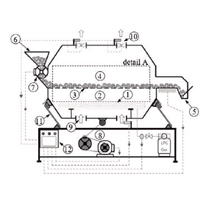Effect of the initial moisture content of the paddy drying operation for the small community

Published: 29 September 2020
Abstract Views: 2146
PDF: 792
HTML: 3820
HTML: 3820
Publisher's note
All claims expressed in this article are solely those of the authors and do not necessarily represent those of their affiliated organizations, or those of the publisher, the editors and the reviewers. Any product that may be evaluated in this article or claim that may be made by its manufacturer is not guaranteed or endorsed by the publisher.
All claims expressed in this article are solely those of the authors and do not necessarily represent those of their affiliated organizations, or those of the publisher, the editors and the reviewers. Any product that may be evaluated in this article or claim that may be made by its manufacturer is not guaranteed or endorsed by the publisher.
Similar Articles
- Bala Gambo Jahun, Desa bin Ahmad, Muhammad Razif Mahadi, Shamsuddin Sulaiman, Shehu Adamu Iya, Effects of degree of oil palm frond mulching using tractor mounted mulcher blades , Journal of Agricultural Engineering: Vol. 52 No. 1 (2021)
- Timothy Denen Akpenpuun, Qazeem Opeyemi Ogunlowo, Wook-Ho Na, Prabhat Dutta, Anis Rabiu, Misbaudeen Aderemi Adesanya, Mohammadreza Nariman, Ezatullah Zakir, Hyeon Tae Kim, Hyun-Woo Lee, Dynamic neural network modeling of thermal environments of two adjacent single-span greenhouses with different thermal curtain positions , Journal of Agricultural Engineering: Vol. 55 No. 2 (2024)
- Simone Pascuzzi, A multibody approach applied to the study of driver injuries due to a narrow-track wheeled tractor rollover , Journal of Agricultural Engineering: Vol. 46 No. 3 (2015)
- Eduard Khasanov, Salavat Mudarisov, Rim Khamaletdinov , Airat Mukhametdinov, Damir Maskulov , Radik Musin, Substantiation of work quality indicators of the universal seeds scarificator of the eastern galega (Galega Orientalis) , Journal of Agricultural Engineering: Vol. 51 No. 3 (2020)
- Giovanni Cascone, Alessandro D'Emilio, Erika Buccellato, CHARACTERIZATION OFWASTE BIOMASS FROM GREENHOUSE ROSE CULTIVATION AND PACKAGING , Journal of Agricultural Engineering: Vol. 41 No. 2 (2010)
- Michele Carrara, Pietro Catania, Felice Pipitone, Mariangela Vallone, Marco Salvia, ASSESSMENT OF THE PEDICEL DETACHING AND CRUSHING FORCES OF GRAPE BERRIES TO DETERMINE THE OPTIMAL MECHANICAL HARVESTING TIME , Journal of Agricultural Engineering: Vol. 38 No. 3 (2007)
- Francesco Barreca, Giuseppe Modica, Salvatore Di Fazio, Viviana Tirella, Raimondo Tripodi, Carmelo Riccardo Fichera, Improving building energy modelling by applying advanced 3D surveying techniques on agri-food facilities , Journal of Agricultural Engineering: Vol. 48 No. 4 (2017)
- Francesco da Borso, Alessandro Chiumenti, Marco Mezzadri, Francesco Teri, Noxious gases in rabbit housing systems: effects of cross and longitudinal ventilation , Journal of Agricultural Engineering: Vol. 47 No. 4 (2016)
- D. Ricauda Aimonino, P. Gay, L. Comba, Application of Computer Vision for quality control in frozen mixed berries production: colour calibration issues , Journal of Agricultural Engineering: Vol. 44 No. s2 (2013): Proceedings of the 10th Conference of the Italian Society of Agricultural Engineering
- A. Assirelli, A. Acampora, S. Croce, R. Spinelli, E. Santangelo, L. Pari, Mechanized recovery of olive pruning residues: ash contamination and harvesting losses , Journal of Agricultural Engineering: Vol. 44 No. s2 (2013): Proceedings of the 10th Conference of the Italian Society of Agricultural Engineering
<< < 29 30 31 32 33 34 35 36 37 38 > >>
You may also start an advanced similarity search for this article.

 https://doi.org/10.4081/jae.2020.1079
https://doi.org/10.4081/jae.2020.1079






